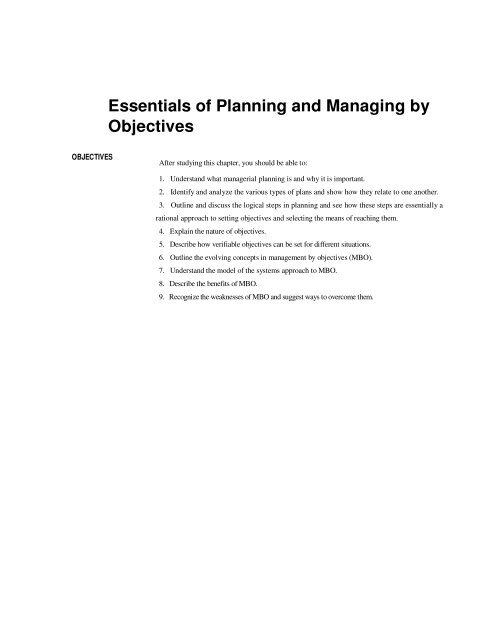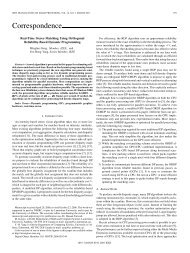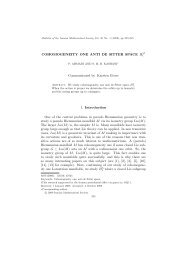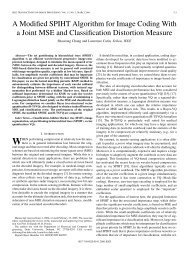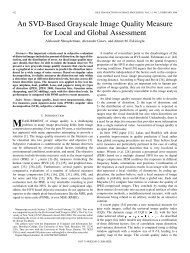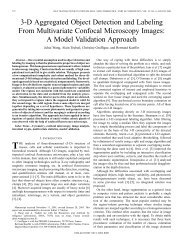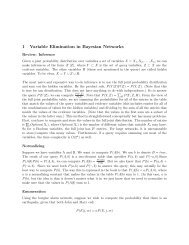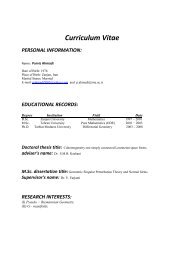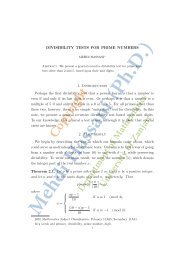Essentials of Planning and Managing by Objectives
Essentials of Planning and Managing by Objectives
Essentials of Planning and Managing by Objectives
You also want an ePaper? Increase the reach of your titles
YUMPU automatically turns print PDFs into web optimized ePapers that Google loves.
<strong>Essentials</strong> <strong>of</strong> <strong>Planning</strong> <strong>and</strong> <strong>Managing</strong> <strong>by</strong><strong>Objectives</strong>OBJECTIVESAfter studying this chapter, you should be able to:1. Underst<strong>and</strong> what managerial planning is <strong>and</strong> why it is important.2. Identify <strong>and</strong> analyze the various types <strong>of</strong> plans <strong>and</strong> show how they relate to one another.3. Outline <strong>and</strong> discuss the logical steps in planning <strong>and</strong> see how these steps are essentially arational approach to setting objectives <strong>and</strong> selecting the means <strong>of</strong> reaching them.4. Explain the nature <strong>of</strong> objectives.5. Describe how verifiable objectives can be set for different situations.6. Outline the evolving concepts in management <strong>by</strong> objectives (MBO).7. Underst<strong>and</strong> the model <strong>of</strong> the systems approach to MBO.8. Describe the benefits <strong>of</strong> MBO.9. Recognize the weaknesses <strong>of</strong> MBO <strong>and</strong> suggest ways to overcome them.
You are now familiar with the basic management theory <strong>and</strong> havebeen introduced to the five essential managerial functions: planning, :organizing, staffing, leading, <strong>and</strong> controlling. In Part 2 <strong>of</strong> this book,we shall discuss planning.In designing an environment for the effective performance <strong>of</strong>individuals working together in a group, a manager's most essential taskis to see that everyone underst<strong>and</strong>s the group's mission <strong>and</strong> objectives<strong>and</strong> the methods for attaining them. If group effort is to be effective,people must know what they are expected to accomplish. This is thefunction <strong>of</strong> planning. It is the most basic <strong>of</strong> all the managerialfunctions. <strong>Planning</strong> involves selecting missions <strong>and</strong> objectives <strong>and</strong>deciding on the actions to achieve them; it requires decision making,that is, choosing a course <strong>of</strong> action from among alternatives. Plansthus provide a rational approach to achieving preselected objectives.<strong>Planning</strong> also strongly implies managerial innovation, as will bediscussed in Chapter 6. <strong>Planning</strong> bridges the gap from where we areto where we want to go. It is also important to point out that planning<strong>and</strong> controlling are inseparable—the Siamese twins <strong>of</strong> management(see Figure 4-1). Any attempt to control without plans ismeaningless, since there is no way for people to tell whether they aregoing where they want to go (the result <strong>of</strong> the task <strong>of</strong> control) unlessthey first know where they want to go (part <strong>of</strong> the task <strong>of</strong> planning).Plans thus furnish the st<strong>and</strong>ards <strong>of</strong> control .
.Types <strong>of</strong> PlansPlans can be classified as (1) missions or purposes, (2) objectives orgoals, (3) strategies, (4) policies, (5) procedures, (6) rules, (7) programs,<strong>and</strong> (8) budgets.Missions or Purposes*The mission, or purpose (the terms are <strong>of</strong>ten used interchangeably),identifies the basic purpose or function or tasks <strong>of</strong> an enterprise oragency or any part <strong>of</strong> it. Every kind <strong>of</strong> organized operation has, or atleast should have if it is to be meaningful, a mission or purpose. In everysocial system, enterprises have a basic function or task assigned to them<strong>by</strong> society. For example, the purpose <strong>of</strong> a business generally is theproduction <strong>and</strong> distribution <strong>of</strong> goods <strong>and</strong> services. The purpose <strong>of</strong> astate highway department is the design, building, <strong>and</strong> operation <strong>of</strong> asystem <strong>of</strong> state highways. The purpose <strong>of</strong> the courts is the interpretation<strong>of</strong> laws <strong>and</strong> theft application. The purpose <strong>of</strong> a university is teaching,research, <strong>and</strong> providing services to the community.Although we do not do so, some writers distinguish between mission<strong>and</strong> purpose. While a business, for example, may have a social purpose <strong>of</strong>producing <strong>and</strong> distributing goods <strong>and</strong> services, it can accomplish this<strong>by</strong> fulfilling a mission <strong>of</strong> producing certain lines <strong>of</strong> products. Themission <strong>of</strong> an oil company, like Exxon, is to search for oil <strong>and</strong> to produce,refine, <strong>and</strong>. market petroleum <strong>and</strong> petrole'um products, from diesel fuelto chemicals. The mission <strong>of</strong> Du Pont has been expressed as "betterthings through chemistry," <strong>and</strong> Kimberly-Clark (noted for its Kleenextrademark) regards its business mission as tne production <strong>and</strong> sale <strong>of</strong> paper<strong>and</strong> paper products. In the 1960s, the mission <strong>of</strong> the National AeronauticsSpace Administration (NASA) was to get a person to the moon beforethe Russians. It is true that in some businesses <strong>and</strong> other enterprises,* Often the term vision is mentioned in connection with the discussion <strong>of</strong> mission. Popular books onmanagement discuss concepts such as goal setting, team management; <strong>and</strong> orientation toward the future,in connection with the discussion <strong>of</strong> vision. A recent study found no agreement among executives <strong>of</strong> themeaning <strong>of</strong> vision. Seven factors, however, were identified in the structure <strong>and</strong> content <strong>of</strong> visionstatements. They were 'formulation, implementation, innovative realism, general, degree <strong>of</strong> detail, riskpropensity, <strong>and</strong> pr<strong>of</strong>it orientation."'
the purpose or mission <strong>of</strong>ten becomes fuzzy. For example, manyconglomerates have regarded their mission as synergy,* which isaccomplished through the combination <strong>of</strong> a variety <strong>of</strong> companies.<strong>Objectives</strong> or Coals<strong>Objectives</strong>, or goals (the terms are used interchangeably in this book), arethe ends toward which activity is aimed. They represent not only the endpoint <strong>of</strong> planning but also the end toward which organizing, staffing, leading,<strong>and</strong> controlling are aimed. The nature <strong>of</strong> objectives <strong>and</strong> management <strong>by</strong>objectives will be discussed in greater detail later in this chapter.StrategiesFor years, the military used the word strategies to mean gr<strong>and</strong> plans made inlight <strong>of</strong> what it was believed an adversary might or might not do. While theterm still usually has a competitive implication, managers increasingly use itto reflect broad areas <strong>of</strong> an enterprise's operation. In this book, strategyis defined as the determination <strong>of</strong> the basic long-term objectives <strong>of</strong> anenterprise <strong>and</strong> the adoption <strong>of</strong> courses <strong>of</strong> action <strong>and</strong> allocation <strong>of</strong> resourcesnecessary to achieve these goals.PoliciesPolicies also are plans in that they are general statements or underst<strong>and</strong>ings that guideor channel thinking in decision making. Not all policies are "statements"; they are<strong>of</strong>ten merely implied from the actions <strong>of</strong> managers. The president <strong>of</strong> a company, forexample, may strictly follow—perhaps for convenience rather than as policy—the practice <strong>of</strong> promoting from within; the practice may then be interpreted as policy<strong>and</strong> carefully followed <strong>by</strong> subordinates. In fact, one <strong>of</strong> the problems <strong>of</strong> managers is tomake sure that subordinates do not interpret as policy minor managerial decisionsthat are not intended to serve as patterns.Policies define an area within which a decision is to be made <strong>and</strong> ensure that thedecision will be consistent with, <strong>and</strong> contribute to, an objective. Policies helpdecide issues before they become problems, make it unnecessary to analyze* The concept <strong>of</strong> synergy can be expressed simply as a situation in which 2 plus 2 becomes equal to 5, orin which the whole is greater than the sum <strong>of</strong> the pans.
the same situation every time it comes up, <strong>and</strong> unify other plans, thuspermitting managers to delegate authority <strong>and</strong> still maintain control overwhat their subordinates do.There are many types <strong>of</strong> policies. Examples include policies <strong>of</strong> hiring onlyuniversity-trained engineers, encouraging employee suggestions for improvedcooperation, promoting from within, conforming strictly to a high st<strong>and</strong>ard<strong>of</strong> business ethics, setting competitive prices, <strong>and</strong> insisting on fixed, ratherthan cost-plus, pricing.ProceduresProcedures are plans that establish a required method <strong>of</strong> h<strong>and</strong>ling futureactivities. They are chronological sequences <strong>of</strong> required actions. They are guidesto action, rather than to thinking, <strong>and</strong> they detail the exact manner in whichcertain activities must be accomplished. For example. Case WesternUniversity outlines three steps for its appraisal process: (1) setting performanceobjectives, (2) performing a mid-year review <strong>of</strong> the objectives, <strong>and</strong> (3) conductinga performance discussion at the end <strong>of</strong> the period.' Procedures <strong>of</strong>ten cutacross departmental lines. For example, in a manufacturing company, theprocedure for h<strong>and</strong>ling orders may involve the sales department (for the originalorder), the finance department (for acknowledgment <strong>of</strong> receipt <strong>of</strong> funds <strong>and</strong> forcustomer credit approval), the accounting department (for recording thetransaction), the production department (for the order to produce the goods orthe authority to release them from stock), <strong>and</strong> the shipping department (fordetermination <strong>of</strong> shipping means <strong>and</strong> route). A few examples illustrate therelationship between procedures <strong>and</strong> policies. Company policy may grantemployees vacations; procedures established to implement this policy willprovide for scheduling vacations to avoid disruption <strong>of</strong> work, setting rates <strong>of</strong>vacation pay <strong>and</strong> methods for calculating them, maintaining records to ensureeach employee <strong>of</strong> a vacation, <strong>and</strong> spelling out the means for applying for leave.
RulesRules spell out specific required actions or nonactions, allowing nodiscretion. They are usually the simplest type <strong>of</strong> plan. "No smoking" is arule that allows no deviation from a stated course <strong>of</strong> action. The essence <strong>of</strong>a rule is that it reflects a managerial decision that a certain action must— ormust not—be taken. Rules are different from policies in that policies aremeant to guide decision making <strong>by</strong> marking <strong>of</strong>f areas in which managers canuse their discretion, while rules allow no discretion in their application.
ProgramsPrograms are a complex <strong>of</strong> goals, policies, procedures, rules, task assignments, steps to be taken,resources to be employed, <strong>and</strong> other elements necessary to carry out a given course <strong>of</strong> action;they are ordinarily supported <strong>by</strong> budgets. They may be as major as an airline's program toacquire a $400 million fleet <strong>of</strong> jets or a five-year program to improve the status <strong>and</strong> quality <strong>of</strong> itsthous<strong>and</strong>s <strong>of</strong> supervisors. Or they may be as minor as a program formulated <strong>by</strong> a singlesupervisor to improve the morale <strong>of</strong> workers in the parts manufacturing department <strong>of</strong> a farmmachinery company.BudgetsA budget is a statement <strong>of</strong> expected results expressed in numerical terms. It may be called a"quantified" plan. In fact, the financial operating budget is <strong>of</strong>ten called a pr<strong>of</strong>it plan. A budgetmay be expressed in financial terms; in terms <strong>of</strong> labor-hours, units <strong>of</strong> product, or machine-hours;or in any other numerically measurable terms. It may deal with operation, as the expense budgetdoes; it may reflect capital outlays, as the capital expenditure budget does; or it may show cashflow, as the cash budget does. One <strong>of</strong> the most comprehensive budgets is prepared <strong>by</strong> the Office<strong>of</strong> Management <strong>and</strong> Budget <strong>of</strong> the White House.6 The budget proposal is then presented to theCongress <strong>by</strong> the President <strong>of</strong> the United States.Since budgets are also control devices, we reserve our principal discussion <strong>of</strong> them forChapter 19 on control techniques. However, making a budget is clearly planning. The budget isthe fundamental planning instrument in many companies. It forces a company to make inadvance— whether for a week or for five years—a numerical compilation <strong>of</strong> expected cash flow,expenses <strong>and</strong> revenues, capital outlays, or labors- or machine-hour utilization. The budget isnecessary for control, but it cannot serve as a sensible st<strong>and</strong>ard <strong>of</strong> control unless it reflects plans.The practical steps listed below, <strong>and</strong> diagramed in Figure 4-2, are <strong>of</strong> general application. In practice, however,one must study the feasibility <strong>of</strong> possible courses <strong>of</strong> action at each stage.
Steps in <strong>Planning</strong>1. Being Aware <strong>of</strong> OpportunitiesAlthough it precedes actual planning <strong>and</strong> is therefore not strictly a part <strong>of</strong> theplanning process, an awareness <strong>of</strong> opportunities* in the external environmentas well as within the organization is the real starting point for planning. Allmanagers should take a preliminary look at possible future opportunities <strong>and</strong> seethem clearly <strong>and</strong> completely, know where their company st<strong>and</strong>s in light <strong>of</strong> itsstrengths <strong>and</strong> weaknesses, underst<strong>and</strong> what problems it has to solve <strong>and</strong> why, <strong>and</strong>know what it can expect to gain. Setting realistic objectives depends on thisawareness. <strong>Planning</strong> requires a realistic diagnosis <strong>of</strong> the opportunity situation.* The word problems might be used instead <strong>of</strong> opportunities. However, a state <strong>of</strong>disorder or confusion <strong>and</strong> a need for a solution to achieve a given goal canmore constructively be regarded as an opportunity. In fact, one verysuccessful <strong>and</strong> astute company president does not permit his colleagues tospeak <strong>of</strong> problems: they must speak only <strong>of</strong> opportunities
2. Establishing <strong>Objectives</strong>The second step in planning is to establish objectives for the entire enterprise <strong>and</strong> then foreach subordinate work unit. This is to be done for the long term as well as for theshort range. <strong>Objectives</strong> specify the expected results <strong>and</strong> indicate the end points <strong>of</strong>what is to be done, where the primary emphasis is to be placed, <strong>and</strong> what is to beaccomplished <strong>by</strong> the network <strong>of</strong> strategies, policies, procedures, rules, budgets, <strong>and</strong>programs.Enterprise objectives give direction to the major plans, which, <strong>by</strong> reflectingthese objectives, define the objective <strong>of</strong> every major department. Major departmentalobjectives in turn control the objectives <strong>of</strong> subordinate departments, <strong>and</strong> so on down theline. In other words, objectives form a hierarchy. The objectives <strong>of</strong> lesserdepartments will be more accurate if subdivision managers underst<strong>and</strong> the overallenterprise objectives <strong>and</strong> the derivative goals. Managers should also have theopportunity to contribute ideas for setting their own goals <strong>and</strong> those <strong>of</strong> the enterprise.3. Developing PremisesThe next logical step in planning is to establish, circulate, <strong>and</strong> obtain agreement toutilize critical planning premises such as forecasts, applicable basic policies, <strong>and</strong>existing company plans. Premises are assumptions about the environment in whichthe plan is to be carried out. It is important for all the managers involved in planningto agree on the premises. In fact, the major principle <strong>of</strong> planning premises isthis: the more thoroughly individuals charged with planning underst<strong>and</strong> <strong>and</strong> agreeto utilize consistent planning premises, the more coordinated enterprise planningwill be.Forecasting is important in premising: What kinds <strong>of</strong> markets will there be? Whatvolume <strong>of</strong> sales? What prices? What products? What technical developments? Whatcosts? What wage rates? What tax rates <strong>and</strong> policies? What new plants? What policieswith respect to dividends? What political or social environment? How will expansionbe financed? What are the long-term trends?4. Determining Alternative CoursesThe fourth step in planning is to search for <strong>and</strong> examine alternative courses <strong>of</strong> action,especially those not immediately apparent. There is seldom a plan for whichreasonable alternatives do not exist, <strong>and</strong> quite <strong>of</strong>ten an alternative that is notobvious proves to be the best.
The more common problem is not finding alternatives but reducingthe number <strong>of</strong> alternatives so that the most promising may beanalyzed. Even with mathematical techniques <strong>and</strong> the computer,there is a limit to the number <strong>of</strong> alternatives that can be thoroughlyexamined. The planner must usually make a preliminaryexamination to discover the most fruitful possibilities.5. Evaluating Alternative CoursesAfter seeking out alternative courses <strong>and</strong> examining their strong<strong>and</strong> weak points, the next step is to evaluate the alternatives <strong>by</strong>weighing them in light <strong>of</strong> premises <strong>and</strong> goals. One course mayappear to be the most pr<strong>of</strong>itable but may require a large cashoutlay <strong>and</strong> have a slow payback; another may look lesspr<strong>of</strong>itable but may involve less risk; still another may better suitthe company's long-range objectives.There are so many alternative courses in most situations <strong>and</strong> somany variables <strong>and</strong> limitations to be considered that evaluationcan be exceedingly difficult. Because <strong>of</strong> these complexities, thenewer methodologies <strong>and</strong> applications <strong>and</strong> analysis arediscussed in Part 6 on controlling.6. Selecting a CourseThis is the point at which the plan is adopted—the real point <strong>of</strong>decision making. Occasionally, an analysis <strong>and</strong> evaluation <strong>of</strong>alternative courses will disclose that two or more are advisable,<strong>and</strong> the manager may decide to follow several courses ratherthan the one best course.7. Formulating Derivative PlansWhen a decision is made, planning is seldom complete, <strong>and</strong> aseventh step is indicated. Derivative plans are almost invariablyrequired to support the basic plan.
8. Quantifying Plans <strong>by</strong> BudgetingAfter decisions are made <strong>and</strong> plans are set, the final step ingiving them meaning, as was indicated in the discussion ontypes <strong>of</strong> plans, is to quantify them <strong>by</strong> converting them intobudgets. The overall budget <strong>of</strong> an enterprise represents the sumtotal <strong>of</strong> income <strong>and</strong> expenses, with resultant pr<strong>of</strong>it or surplus,<strong>and</strong> the budgets <strong>of</strong> major balance sheet items such as cash <strong>and</strong>capital expenditures. Each department or program <strong>of</strong> abusiness or some other enterprise can have its own budgets,usually <strong>of</strong> expenses <strong>and</strong> capital expenditures, which tie intothe overall budget. If done well, budgets become a means <strong>of</strong>adding the various plans <strong>and</strong> set important st<strong>and</strong>ards againstwhich planning progress can be measured.Coordination <strong>of</strong> Short- <strong>and</strong> Long-Range PlansOften short-range plans are made without reference to long-range plans.This is plainly a serious error. The importance <strong>of</strong> integrating the twotypes can hardly be overemphasized, <strong>and</strong> no short-run plan should bemade unless it contributes to the achievement <strong>of</strong> the relevant long-rangeplan.Much waste arises from decisions about immediate situations that fail toconsider their effect on more remote objectives.Responsible managers should continually review <strong>and</strong> revise immediatedecisions to determine whether they contribute to long-range programs,<strong>and</strong> subordinate managers should be regularly briefed on long-range plansso that they will make decisions consistent with the company's long-rangegoals. Doing this is far easier than to correct inconsistencies later, especiallysince short-term commitments tend to lead to further commitments alongthe same line.
<strong>Objectives</strong><strong>Objectives</strong> were defined earlier as the important ends toward which organizational <strong>and</strong>individual activities are directed. Since writers <strong>and</strong> practitioners make no clear distinctionbetween the terms goal <strong>and</strong> objectives, they are used interchangeably in this book. Within thecontext <strong>of</strong> the discussion, it will become dear whether the objectives are long term or shortterm, broad or specific. The emphasis is on verifiable objectives, which means at the end <strong>of</strong>the period it should be possible to determine whether or not the objective has been achieved.The goal <strong>of</strong> every manager is to create a surplus (in business organizations, this means pr<strong>of</strong>it).Clear <strong>and</strong> verifiable objectives facilitate measurement <strong>of</strong> the surplus as well as the effectiveness <strong>and</strong>efficiency <strong>of</strong> managerial actions.The Nature <strong>of</strong> <strong>Objectives</strong><strong>Objectives</strong> state end results, <strong>and</strong> overall objectives need to be supported <strong>by</strong> sub objectives. Thus,objectives form a hierarchy as well as a network. Moreover, organizations <strong>and</strong> managers havemultiple goals that are sometimes incompatible <strong>and</strong> may lead to conflicts within the organization,within the group, <strong>and</strong> even within individuals. A manager may have to choose between shortterm<strong>and</strong> long-term performance, <strong>and</strong> personal interests may have to be subordinated toorganizational objectives.
Hierarchy <strong>of</strong> objectivesAs Figure 4-3 shows, objectives form a hierarchy, ranging from the broad aim to specificindividual objectives. The zenith <strong>of</strong> the hierarchy is the purpose or mission, which hastwo dimensions. First, there is the social purpose, such as contributing to the welfare <strong>of</strong>people <strong>by</strong> providing goods <strong>and</strong> services at a reasonable price. Second, there is themission or purpose
<strong>of</strong> the business, which might be to furnish convenient, low-cost transportation forthe average person. The stated mission might be to produce, market, <strong>and</strong>service automobiles. As you will notice, the distinction between purpose <strong>and</strong>mission is a fine one, <strong>and</strong> therefore many writers <strong>and</strong> practitioners do notdifferentiate between the two terms. At any rate, these aims are in turn translatedinto general objectives <strong>and</strong> strategies, such as designing, producing, <strong>and</strong>marketing reliable, low-cost, fuel-efficient automobiles.The next level <strong>of</strong> the hierarchy contains more specific objectives, such as thosein the key result areas. These are the areas in which performance is essential forthe success <strong>of</strong> the enterprise.Although there is no complete agreement on what the key result areas <strong>of</strong> abusiness should be—<strong>and</strong> they may differ between enterprises—Peter F. Druckersuggests the following: market st<strong>and</strong>ing, innovation, productivity, physical<strong>and</strong> financial resources, pr<strong>of</strong>itability, manager performance <strong>and</strong> development,worker performance <strong>and</strong> attitude, <strong>and</strong> public responsibility. 8 More recently,however, two other key result areas have 'become <strong>of</strong> strategic importance: service<strong>and</strong> quality.
Examples <strong>of</strong> objectives for key result areas are the following: toobtain a 10 percent return on investment <strong>by</strong> the end <strong>of</strong> calendar year2005 (pr<strong>of</strong>itability); to increase the number <strong>of</strong> units <strong>of</strong> product Xproduced <strong>by</strong> 7 percent <strong>by</strong> June 30, 2005 without raising costs orreducing the current quality level (productivity).The objectives have to be further translated into those <strong>of</strong>divisions, departments, <strong>and</strong> units down to the lowest level <strong>of</strong> theorganization.Setting objectives <strong>and</strong> the organizational hierarchyAs Figure 4-3 shows, managers at different levels in theorganizational hierarchy are concerned with different kinds <strong>of</strong>objectives. The board <strong>of</strong> directors <strong>and</strong> top-level managers are verymuch involved in determining the purpose, the mission, <strong>and</strong> theoverall objectives <strong>of</strong> the firm, as well as the more specific overallobjectives in the key result areas. Middle-level managers, such asthe vice president or manager <strong>of</strong> marketing or the productionmanager, are involved in the setting <strong>of</strong> key-result area objectives,division objectives, <strong>and</strong> departmental objectives. The primaryconcern <strong>of</strong> lower-level managers is setting the objectives <strong>of</strong>departments <strong>and</strong> units as well as <strong>of</strong> their subordinates. Althoughindividual objectives, consisting <strong>of</strong> performance <strong>and</strong> developmentgoals, are shown at the bottom <strong>of</strong> the hierarchy, managers at higherlevels also should set objectives for their own performance <strong>and</strong>development.' There are different views about whether an organization shoulduse the top-down or the bottom-up approach in setting objectives, asindicated <strong>by</strong> the arrows in Figure 4-3. In the top-down approachupper-level managers determine the objectives for subordinates,while in the bottom-up approach subordinates initiate the setting <strong>of</strong>objectives for their positions <strong>and</strong> present them to their superior.Proponents <strong>of</strong> the top-down approach suggest that the totalorganization needs direction through corporate objectives provided<strong>by</strong> the chief executive <strong>of</strong>ficer (in conjunction with the board <strong>of</strong>
directors). Proponents <strong>of</strong> the bottom-up approach, on the other h<strong>and</strong>,argue that top management needs to have information from lowerlevels in the form <strong>of</strong> objectives. In addition, subordinates are likely tobe highly motivated <strong>by</strong>, <strong>and</strong> committed to, goals that they initiate.Personal experience has shown that the bottom-up approach isunderutilized but that either approach alone is insufficient.
Multiplicity <strong>of</strong> objectives<strong>Objectives</strong> are normally multiple. For example, merely stating that auniversity's mission is education <strong>and</strong> research is not-enough. It would be muchmore accurate (but still not verifiable) to list the overall objectives, which mightbe the following:• Attracting students <strong>of</strong> high quality• Offering basic training in the liberal arts <strong>and</strong> sciences as well as in certainpr<strong>of</strong>essional fields• Granting postgraduate degrees to qualified c<strong>and</strong>idates• Attracting highly regarded pr<strong>of</strong>essors• Discovering <strong>and</strong> organizing new knowledge through research• Operating as a private school supported principally through tuition <strong>and</strong> gifts<strong>of</strong> alumni <strong>and</strong> friendsLikewise, at every level in the hierarchy <strong>of</strong> objectives, goals are likely to bemultiple. Some people think that a manager cannot effectively pursue more thantwo to five objectives. The argument is that too many objectives tend to dilutethe drive for their accomplishment. But the limit <strong>of</strong> two to five objectives seemstoo arbitrary; managers might pursue more significant objectives. It would be wiseto state the relative importance <strong>of</strong> each objective so that major goals receive moreattention than lesser ones. At any rate, the number <strong>of</strong> objectives managersshould realistically set for themselves depends on how much they will dothemselves <strong>and</strong> how much they can assign to subordinates, there<strong>by</strong> limitingtheir role to one <strong>of</strong> assigning, supervising, <strong>and</strong> controlling.How to Set <strong>Objectives</strong> 10Without dear objectives, managing is haphazard. No individual <strong>and</strong> no groupcan expect to perform effectively <strong>and</strong> efficiently unless there is a dear aim.Table 4-1 illustrates some objectives <strong>and</strong> how they can be restated in a way thatallows measurement.Quantitative <strong>and</strong> qualitative objectivesTo be measurable, objectives must be verifiable. This means that one must beable to answer this question: At the end <strong>of</strong> the period, how do I know 'if theobjective has been accomplished? For example the objective <strong>of</strong>
Examples <strong>of</strong> nonverifiable <strong>and</strong> verifiable objectivesNonverifiable objective1. To make a reasonable pr<strong>of</strong>it2. To improve communication3. To improve productivity <strong>of</strong>the production department4. To develop better managers5. To install a computer systemVerifiable objective1. To achieve a return on investment <strong>of</strong> 12% at the end <strong>of</strong> the current fiscal year2. To issue a two-page monthly newsletter beginning July 1, 2005, involving notmore than 40 working hours <strong>of</strong> preparation time (after the first issue)3. To increase production output <strong>by</strong> 5% <strong>by</strong> December 31, 2005, withoutadditional costs while maintaining the current quality level4. To design <strong>and</strong> conduct a 40-hour in-house program on the "fundamentals <strong>of</strong>management," to be completed <strong>by</strong> October 1, 2005, involving not more than 200working hours <strong>of</strong> the management development staff <strong>and</strong> with at least 90% <strong>of</strong>the 100 managers passing the exam (specified)5. To install a computerized control system in the production department <strong>by</strong>December 31, 2005, requiring not more than 500 working hours <strong>of</strong> systemsanalysis <strong>and</strong> operating with not more than 10% downtime during the first threemonths or 2% thereaftermaking a reasonable pr<strong>of</strong>it (see Table 4-1) does not state how much pr<strong>of</strong>it isto be made, <strong>and</strong> what is reasonable to the subordinate may not be at allacceptable to the superior. In the case <strong>of</strong> such a disagreement, it is <strong>of</strong>course the subordinate who loses the argument. In contrast, a return oninvestment <strong>of</strong> 12 percent at the end <strong>of</strong> the current fiscal year can bemeasured; it answers these questions: how much or what? when?At times, stating results in verifiable terms is more difficult. This isespecially true when it involves the objectives for staff personnel <strong>and</strong> ingovernment. For example, installing a computer system is an importanttask, but "to install a computer system" is not a verifiable goal. However,suppose the objective is "to install a computerized control system (withcertain specifications) in the production department <strong>by</strong> December 31, 2005,with an expenditure <strong>of</strong> not more than 500 working hours." Then, goalaccomplishment can be measured. Moreover, quality can also be specified interms <strong>of</strong> computer downtime, such as "the system shall be operational 90percent <strong>of</strong> the time during the first two months <strong>of</strong> operation."Guidelines for setting objectivesSetting objectives is indeed a difficult task. It requires intelligent coaching <strong>by</strong>the superior <strong>and</strong> extensive practice <strong>by</strong> the subordinate. The guidelinesshown in Table 4-1 will help managers in setting their objectives.The list <strong>of</strong> objectives should not be too long, yet it should cover themain features <strong>of</strong> the job. As this chapter has emphasized, objectives shouldbe verifiable <strong>and</strong> should state what is to be accomplished <strong>and</strong> when. Ifpossible, the quality desired <strong>and</strong> the projected cost <strong>of</strong> achieving theobjectives should be indicated. Furthermore, objectives should present achallenge, indicate priorities, <strong>and</strong> promote personal <strong>and</strong> pr<strong>of</strong>essionalgrowth <strong>and</strong> development. These <strong>and</strong> other criteria for good objectives arebe summarized in Table 4-1. Testing objectives against the criteriashown in the checklist is a good exercise for managers <strong>and</strong> aspiringmanagers.
113evolving Concepts in Management <strong>by</strong> <strong>Objectives</strong> 11Management <strong>by</strong> objectives (MBO) is now practiced around the world. Yet, despite itswide application, it is not always clear what is meant <strong>by</strong> MBO. Some still think <strong>of</strong> it as anappraisal tool; others see it as a motivational technique; still others consider MBO aplanning <strong>and</strong> control device. In other words, definitions <strong>and</strong> applications <strong>of</strong> MBO differwidely. We define management <strong>by</strong> objectives as a comprehensive managerial system thatintegrates many key managerial activities in a systematic manner <strong>and</strong> is consciouslydirected toward the effective <strong>and</strong> efficient achievement <strong>of</strong> organizational <strong>and</strong> individualobjectives. This view <strong>of</strong> MBO as a system <strong>of</strong> managing is not shared <strong>by</strong> all. While some stilldefine MBO in a very narrow, limited way, we prefer to see it as a comprehensive goal-driven,success-oriented management system as shown in Figure 4-4. Besides being used forperformance appraisal, as an instrument for motivating individuals, <strong>and</strong> in strategicplanning, there are still other managerial subsystems that can be integrated into the MBOprocess. They include human resource planning <strong>and</strong> development (staffing as well asindividual <strong>and</strong> organization development), career planning (building on personal strengths<strong>and</strong> overcoming weaknesses), the reward system (paying for performance), budgeting(planning <strong>and</strong> controlling), <strong>and</strong> other managerial activities important for a specific position.These various managerial activities need to be integrated into a system. In short, MBO, to beeffective, must be considered a way <strong>of</strong> managing as shown in Figure 4-4, <strong>and</strong> not an addition tothe managerial job. 12Benefits <strong>and</strong> Weaknesses <strong>of</strong> Management <strong>by</strong> <strong>Objectives</strong>Although goal-oriented management-is now one <strong>of</strong> the most widely practiced managerialapproaches, its effectiveness is sometimes questioned. Faulty implementation is <strong>of</strong>ten blamed,but another reason is that MBO may be applied as a mechanistic technique focusing onselected aspects <strong>of</strong> the managerial process without integrating them into a system.Benefits <strong>of</strong> management <strong>by</strong> objectivesThere is considerable evidence, much <strong>of</strong> it from laboratory studies, that Shows themotivational aspects <strong>of</strong> clear goals. But there are other benefits, such as the following:
Adapted from Heinz Weihrich, Management Excellence: Productivity through MBO (New York: McGraw-Hill, 1985), p. 18.• improvement <strong>of</strong> managing through results-oriented planning• Clarification <strong>of</strong> organizational roles <strong>and</strong> structures as well as delegation <strong>of</strong> authorityaccording to the results expected <strong>of</strong> the people occupying the roles• Encouragement <strong>of</strong> commitment to personal <strong>and</strong> organizational goals• Development <strong>of</strong> effective controls that measure results <strong>and</strong> lead to corrective actions
Failures <strong>of</strong> management <strong>by</strong> objectives <strong>and</strong> some recommendationsDespite all its advantages, an MBO system has a number <strong>of</strong> weaknesses. Most aredue to shortcomings in applying the MBO concepts. Failure to teach thephilosophy <strong>of</strong> MBO is one <strong>of</strong> the weaknesses <strong>of</strong> certain programs. Managers mustexplain to subordinates what it is, how it works, why it is being done, what part itwill play in appraising performance, <strong>and</strong>, above all, how participants can benefit.The philosophy is built on the concepts <strong>of</strong> self-control <strong>and</strong> self-direction.Failure to give guidelines to goal setters is <strong>of</strong>ten another problem. Managersmust know what the corporate goals are <strong>and</strong> how their own activities fit in withthem. Managers also need planning premises <strong>and</strong> a knowledge <strong>of</strong> major companypolicies.There is also the difficulty <strong>of</strong> setting verifiable goals with the right degree <strong>of</strong>flexibility. Participants in MBO programs report at times that the excessiveconcern with economic results puts pressure on individuals that may encouragequestionable behavior. To reduce the probability <strong>of</strong> resorting to unethicalmeans to achieve results, top management must agree to reasonable objectives,clearly state behavioral expectations, <strong>and</strong> give high priority to ethical behavior,rewarding it as well as punishing unethical activities.In addition, emphasis on short-run goals can be done at the expense <strong>of</strong> thelonger-range health <strong>of</strong> the organization. Moreover, the danger <strong>of</strong> inflexibilitycan make managers hesitate to change objectives, even if a changed environmentwould require such adjustments.Other dangers include the overuse <strong>of</strong> quantitative goals <strong>and</strong> the attempt to usenumbers in areas where they are not applicable, or they may downgradeimportant goals that are difficult to state in terms <strong>of</strong> end results. For example, afavorable company image may be the key strength <strong>of</strong> an enterprise, yet statingthis in quantitative terms is difficult. There is also the danger <strong>of</strong> forgetting thatmanaging involves more than goal setting.But even with the difficulties <strong>and</strong> dangers <strong>of</strong> managing <strong>by</strong> objectives in certainsituations, this system emphasizes in practice the setting <strong>of</strong> goals long known tobe an essential part <strong>of</strong> planning <strong>and</strong> managing.
Summary<strong>Planning</strong> involves selecting the missions <strong>and</strong> objectives as well as the actions toachieve them. It requires decision making, which means choosing a futurecourse <strong>of</strong> action from among alternatives. <strong>Planning</strong> <strong>and</strong> controlling are closelyinterrelated, although they are discussed separately in this book There are manytypes <strong>of</strong> plans, such as missions or purposes, objectives or goals, strategies, policies,procedures, rules, programs, <strong>and</strong> budgets. Once an opportunity is recognized, amanager plans rationally <strong>by</strong> establishing objectives, making assumptions (premises)about the present <strong>and</strong> future environment, finding <strong>and</strong> evaluating alternative courses <strong>of</strong>action, <strong>and</strong> choosing a course to follow. Next, the manager must make supportingplans <strong>and</strong> devise a budget. These activities must be carried out with attention to thetotal environment. Short-range plans must <strong>of</strong> course be coordinated with long-rangeplans.<strong>Objectives</strong> are the end points toward which activities are aimed. <strong>Objectives</strong> areverifiable if it is possible, at the end <strong>of</strong> the period, to determine whether they havebeen accomplished. <strong>Objectives</strong> form a hierarchy, starting from corporate missions orpurposes going down to individual goals. Managers can best determine the number<strong>of</strong> objectives they should realistically set for themselves <strong>by</strong> analyzing the nature <strong>of</strong>the job <strong>and</strong> how much they can do themselves <strong>and</strong> how much they can delegate. Inany case, managers should know the relative importance <strong>of</strong> each <strong>of</strong> their goals.Management <strong>by</strong> objectives (MBO) has been widely used for performanceappraisal <strong>and</strong> employee motivation, but it is really a system <strong>of</strong> managing. Among itsbenefits, MBO results in better managing, <strong>of</strong>ten forces managers to clarify thestructure <strong>of</strong> their organizations, encourages people to commit themselves to theirgoals, <strong>and</strong> helps develop effective controls.Some <strong>of</strong> its weaknesses are that managers sometimes fail to explain thephilosophy <strong>of</strong> MBO (which emphasizes self-control <strong>and</strong> self-direction) tosubordinates or give them guidelines for their goal setting. In addition, goalsthemselves are difficult to set, tend to be short-term, <strong>and</strong> may become inflexibledespite changes in the environment. People, in their search for verifiability, mayoveremphasize quantifiable goals.
KEY IDEAS AND CONCEPTSFOR REVIEW<strong>Planning</strong>Mission or purposeObjective or goalStrategyPolicyProcedureRuleEvolving concepts in management <strong>by</strong>objectives (MBO) Systemsapproach to MBOProgramBudget<strong>Planning</strong> stepsHierarchy <strong>of</strong> objectives •Key result areasQuantitative <strong>and</strong> qualitativeobjectivesVerifiabilityBenefits <strong>of</strong> MBO Weaknesses <strong>of</strong>MBO Recommendations forimproving MBO
FOR DISCUSSION1. "<strong>Planning</strong> is looking ahead, <strong>and</strong> control is looking back." Comment.2. Draw up a statement <strong>of</strong> policy <strong>and</strong> devise a brief procedure that might beuseful in implementing it. Are you sure your policy is not a rule?3. Take an organization that you know <strong>and</strong> identify its purpose or mission,even if it is not formally stated <strong>by</strong> the enterprise.4. To what extent do you believe that managers you have known in business orelsewhere have a clear underst<strong>and</strong>ing <strong>of</strong> their objectives? If you think they donot, how would you suggest that they go about setting their objectives?5. Some people object to defining long-term goals because they think thatknowing what will happen over a long period is impossible. Do you believe thisis an intelligent position to take? Why or why not?6. Do you think that managing <strong>by</strong> objectives could be introduced in agovernment agency? A university? A college fraternity or sorority?7. What are your five most important personal objectives? Are they long- orshort-range? Are the objectives verifiable?8. In your organization, what does your superior expect from you in terms <strong>of</strong>performance? Is it stated in writing? If you wrote down your job objective <strong>and</strong>your boss wrote down what he or she expects <strong>of</strong> you, would the two beconsistent?EXERCISE/ACTION STEPSIn this chapter, the overall objectives <strong>of</strong> a university were identified. Developoverall objectives for your university, for your college, <strong>and</strong> for the variousdepartments in your college. Show how these objectives are interrelated to form anetwork.INTERNET RESEARCH1. Use a search engine to look for "management <strong>by</strong> objectives" <strong>and</strong> identify howMBO is used: as a planning tool? for managerial appraisal? for motivatingpeople? in conjunction with strategic planning? for developing managers?2. Search the Internet for the term "budget" <strong>and</strong> discuss your findings with theclass.


